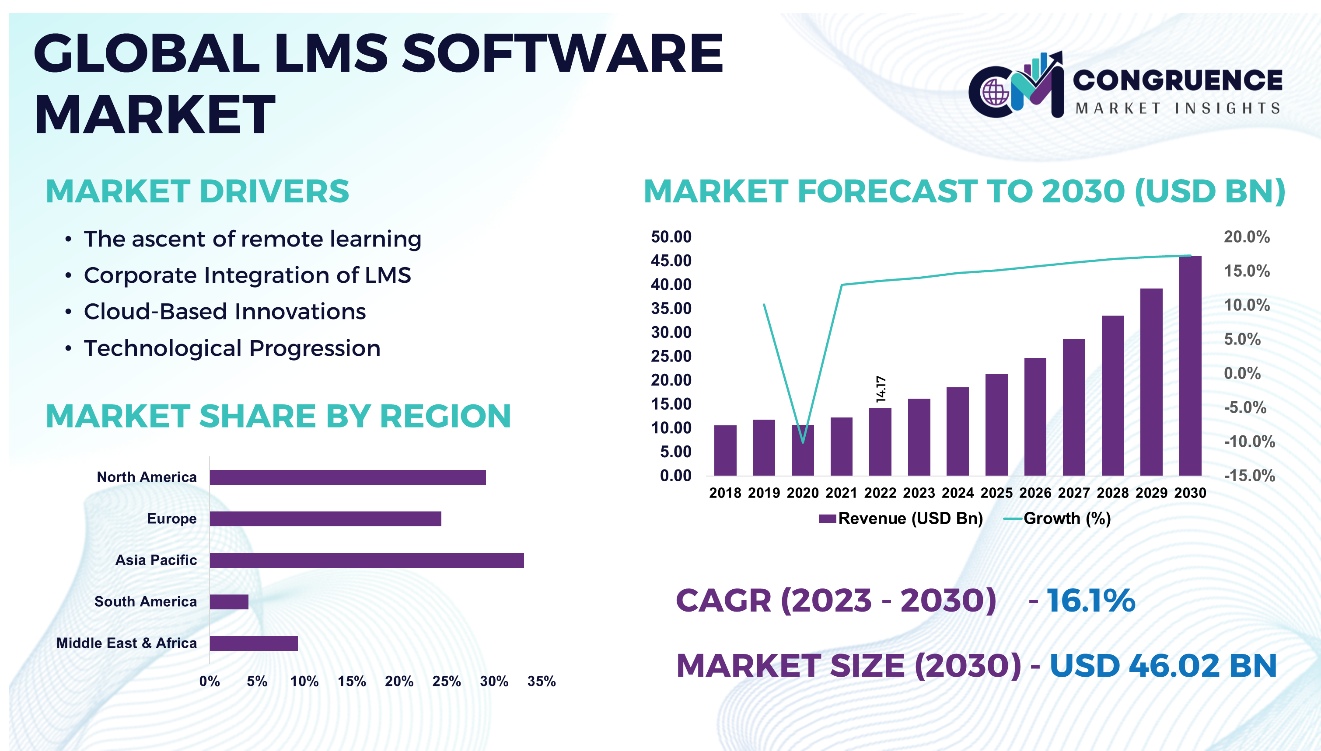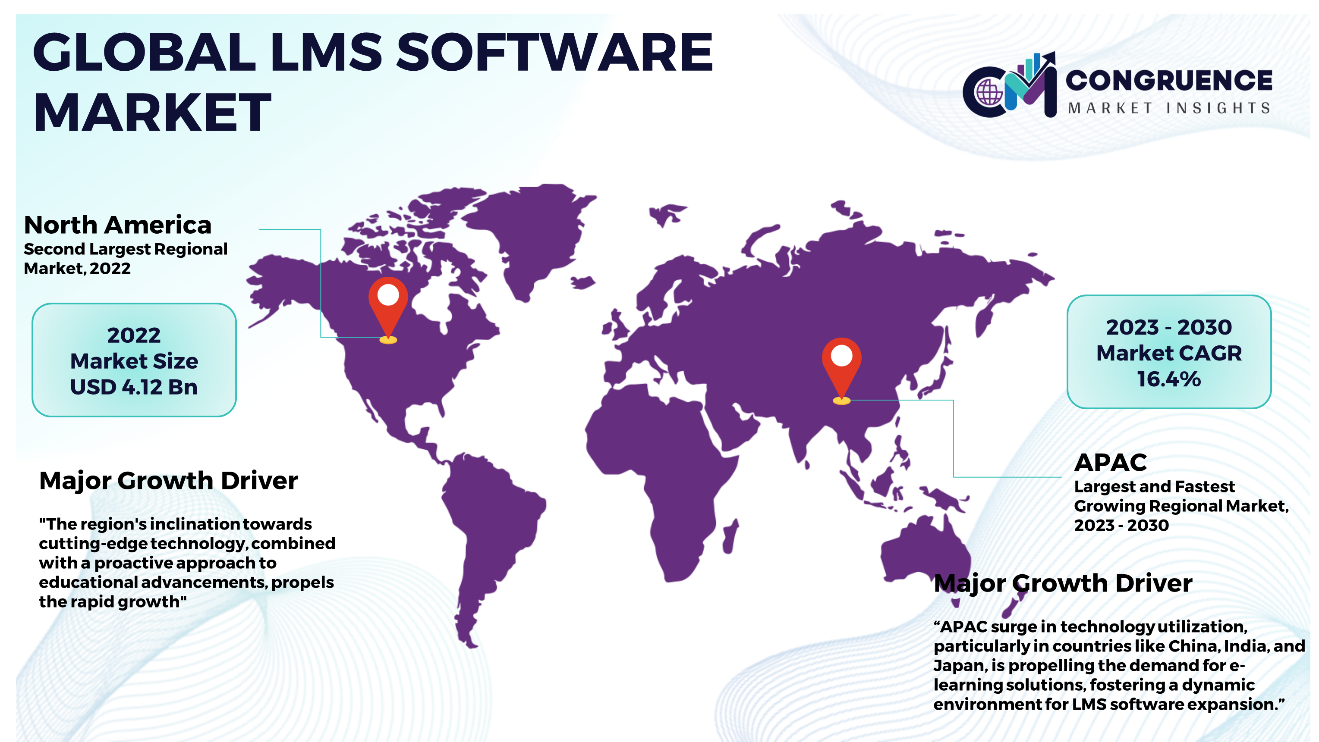Reports
The Global LMS Software Market was valued at USD 14.17 Bn in 2022 and is anticipated to reach a value of USD 46.02 Bn by 2030 expanding at a CAGR of 16.1% between 2023 and 2030.
A Learning Management System (LMS) is a sophisticated software application meticulously designed to streamline the comprehensive oversight, documentation, monitoring, and distribution of educational courses or training programs. These systems find extensive utility across a spectrum of environments, including educational institutions, corporate training arenas, and online learning platforms, fundamentally reshaping the landscape of educational administration and delivery. Notably, the LMS software market witnessed remarkable expansion and advancement, chiefly driven by the surging demand for remote learning solutions due to the COVID-19 pandemic and the escalating prevalence of e-learning. The widespread adoption of cloud-based LMS solutions can be attributed to their inherent benefits in scalability, accessibility, and cost-effectiveness. Furthermore, the corporate sector increasingly embraced LMS software for the purpose of employee training and professional development. This market is characterized by intense competition, necessitating providers to continuously enrich their offerings to address the evolving needs of educational institutions, corporate entities, and individual users.

LMS Software Market Major Driving Forces
Ascent of Remote Learning: The amplified need for remote learning solutions has served as a principal catalyst. The COVID-19 pandemic markedly expedited the adoption of online education, engendering a substantial upsurge in the requisition for LMS software to enable remote learning in educational institutions, corporate training facilities, and individual learning platforms.
Corporate Integration of LMS: Corporations are increasingly leveraging LMS software for the purpose of employee training and advancement, thus contributing to market growth. As enterprises recognize the significance of upskilling and continual learning, they are allocating resources towards these systems to streamline and optimize their internal training initiatives.
Cloud-Based Innovation: The elevation in demand for cloud-based LMS solutions, owing to their scalability, accessibility, and cost-efficiency, has been a pivotal driving force. Cloud-centric systems proffer flexibility, seamless access, and reduced infrastructure expenses, accommodating the diverse requisites of users across various sectors.
Technological Progression: Ongoing advancements in technology, exemplified by AI integration, machine learning, and data analytics embedded within LMS software, have notably augmented personalized learning experiences, adaptive learning pathways, and enhanced content delivery, thereby propelling market expansion.
LMS Software Market Key Opportunities
Adaptive Learning Technology: The integration of adaptive learning technologies within LMS software stands as a significant prospect. These technologies personalize learning experiences by tailoring content based on individual progress, learning styles, and aptitudes. As advancements persist, the integration of AI and machine learning in LMS has the potential to further customize learning content, thus amplifying engagement and fostering improved knowledge retention.
Augmented and Virtual Reality Integration: The integration of augmented reality (AR) and virtual reality (VR) within LMS software introduces fresh avenues for immersive and interactive learning experiences. These technologies offer a more immersive and practical approach to learning, particularly in sectors such as medicine, engineering, and vocational training. Their integration into LMS platforms represents an enticing opportunity for more effective and lifelike training scenarios.
Data Analytics and Personalized Learning Pathways: Leveraging extensive data analytics capabilities within LMS software to derive insights into user behaviors, learning patterns, and outcomes presents an opportunity. This data can be utilized to develop more personalized learning pathways, thereby enhancing learning outcomes and bolstering user engagement.
LMS Software Market Key Trends
· LMS providers are presently intensifying their focus on augmenting user experience (UX). They aim to craft interfaces that are more intuitive, interactive, and accommodating of diverse learning styles and preferences.
· There is active engagement from LMS providers in optimizing platforms for mobile devices to ensure responsiveness and deliver a seamless learning experience on smartphones and tablets, acknowledging the sustained surge in mobile usage.
· A prevalent trend pertains to the adoption of microlearning, offering condensed learning modules for rapid consumption to cater to shorter attention spans and facilitate on-the-go learning.
· AI integration within LMS software is rapidly gaining traction, enabling the creation of personalized learning pathways through the adaptation of content according to individual progress, preferences, and learning styles.
· Encouraging collaborative learning experiences and fostering social interaction within LMS platforms is presently a burgeoning practice. This encompasses features such as discussion forums, group projects, and opportunities for peer-based learning.
· Strategic utilization of gamification elements like badges, leaderboards, and rewards within LMS is employed to enhance engagement and motivation among learners.
· There is a heightened emphasis on interoperability in LMS software, with providers increasingly working on integration with various tools and systems, facilitated through APIs, encompassing CRM, HRM, and content management systems.
Region-wise Market Insights
Asia Pacific accounted for the largest market share at 33.1% in 2022 whereas, North America is expected to register the second largest market share, expanding at a CAGR of 16.2% between 2023 and 2030.

The Asia Pacific region has positioned itself as a predominant force in the LMS software market owing to several pivotal factors. Marked by a swiftly expanding economy, a notable uptick in technology adoption, and a concentrated emphasis on education and professional development, the Asia Pacific has experienced a substantial upsurge in the requirement for e-learning solutions. The increasing penetration of the internet, in conjunction with the proliferation of mobile devices, has played a significant role in driving the heightened adoption of online learning platforms. Moreover, the region's sizable and diverse population, coupled with a pronounced demand for continuous learning and skills enhancement, has bolstered the need for LMS software, not solely confined to academic institutions but also within the corporate sector. Noted for its technological progress and steadfast dedication to education, North America presently demonstrates the second most elevated growth rate in the LMS software market. The region boasts a robust economy and a thriving technology industry, fostering the adoption of innovative solutions and resulting in a substantial increase in the uptake of e-learning platforms. North America's persistent commitment to technological advancement and education further cements its status as a pivotal contributor and a rapidly expanding market within the LMS software sector. Owing to its significant focus on education, Europe has allocated considerable investments toward digital learning solutions, cultivating an environment conducive to the extensive adoption of e-learning platforms. The UAE and Saudi Arabia in the Middle East are adopting e-learning due to tech advances and focus on education, expecting greater LMS use. Likewise, Brazil and Argentina in South America emphasize e-learning, especially for remote education and workforce development, anticipating increased LMS market involvement due to growing internet access and government-led digital education promotion.
Segment-wise Market Analysis
· Cloud-based tends to be the largest segment as a deployment model in the LMS Software market. It is the prevailing force primarily due to its inherent advantages. Offering unmatched flexibility, accessibility, and cost-effectiveness, this method meets diverse user needs across multiple sectors. The scalability and ease of access provided by cloud-based systems greatly contribute to their market prevalence.
· In the LMS software market, Educational Institutions are dominating as primary end-users due to the demand for centralized platforms that streamline learning experiences and administrative tasks. LMS systems offer structured approaches that facilitate seamless learning for students and simplify management for instructors. Institutions increasingly adopt LMS software to cater to diverse learning needs, adapt to remote learning, and meet the rising demand for personalized, digital education experiences.
Market Competition Landscape
The global LMS Software market showcases a high level of competition among various manufacturers. Key participants within this market employ strategic methodologies to gain a competitive edge. These methodologies involve innovations in products, unique design features, and the incorporation of sustainable materials, meeting the changing preferences of consumers. Established brands capitalize on their esteemed status for reliability and excellence to sustain their market leadership, while new entrants focus on groundbreaking innovations and distinct propositions to establish their presence within the industry.
Key players in the global LMS Software market implement various organic and inorganic strategies to strengthen and improve their market positioning. Prominent players in the market include:
· D2L Corporation
· Instructure, Inc.
· Adobe
· Anthology Inc.
· Moodle
· SAP
· Cornerstone
· Docebo S.p.A.
· Schoology
· Epignosis
· Edmodo
|
Report Attribute/Metric |
Details |
|
Market Revenue in 2022 |
USD 16.15 Bn |
|
Market Revenue in 2030 |
USD 46.02 Bn |
|
CAGR (2023 – 2030) |
16.1% |
|
Base Year |
2022 |
|
Forecast Period |
2023 – 2030 |
|
Historical Data |
2018 to 2022 |
|
Forecast Unit |
Value (US$ Bn) |
|
Key Report Deliverable |
Revenue Forecast, Growth Trends, Market Dynamics, Segmental Overview, Regional and Country-wise Analysis, Competition Landscape |
|
Segments Covered |
· By Deployment Model (Cloud-Based, On-Premise) · By Delivery Mode (E-Learning, Blended Learning, M-Learning (Mobile Learning), Others) · By End User (Enterprise, Institutions, Government, Others) |
|
Geographies Covered |
North America: U.S., Canada and Mexico Europe: Germany, France, U.K., Italy, Spain, and Rest of Europe Asia Pacific: China, India, Japan, South Korea, Southeast Asia, and Rest of Asia Pacific South America: Brazil, Argentina, and Rest of Latin America Middle East & Africa: GCC Countries, South Africa, and Rest of Middle East & Africa |
|
Key Players Analyzed |
D2L Corporation, Instructure, Inc., Adobe, Anthology Inc., Moodle, SAP, Cornerstone, Docebo S.p.A., Schoology, Epignosis, Edmodo |
|
Customization & Pricing |
Available on Request (10% Customization is Free) |
